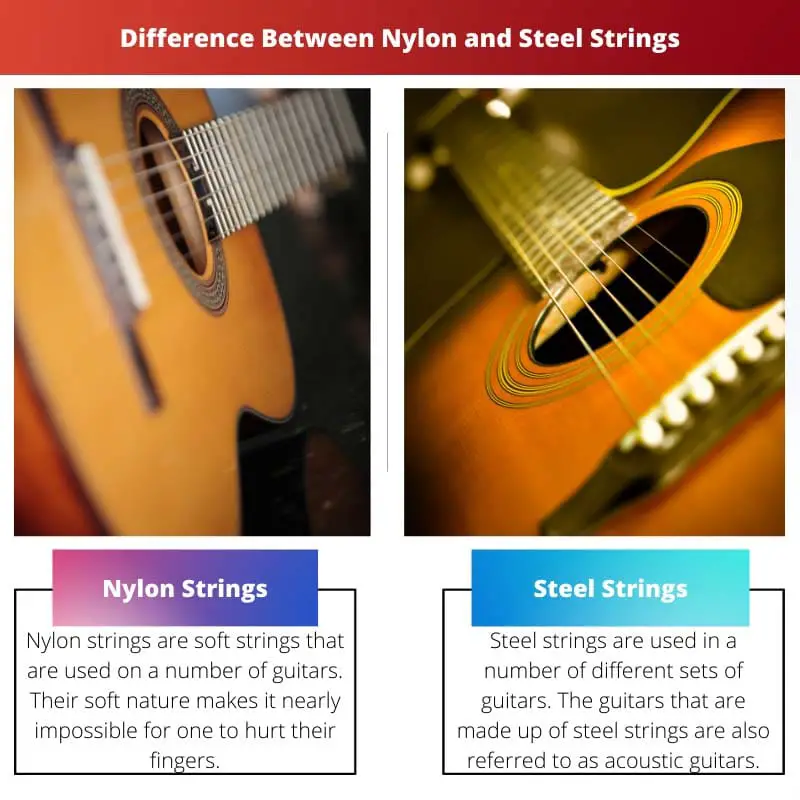There are different types of strings used in a guitar. Some are made of nylon, some are made of aluminum bronze, some are made of catgut, and some others are made up of steel.
We’ll be focusing mainly on nylon and steel strings. Both are quite different in their features but are used for the same purpose.
Key Takeaways
- Nylon strings are common in classical guitars and produce a warm, mellow sound, while steel strings are used in acoustic guitars and have a bright, crisp tone.
- Nylon strings have lower tension and are easier on the fingers, making them suitable for beginners, while steel strings require more finger strength and precision.
- Nylon strings are more sensitive to changes in temperature and humidity than steel strings, which may affect their tuning stability.
Nylon vs Steel Strings
Nylon strings, used on classical and folk guitars, provide a mellow and gentle tone, ideal for fingerpicking.Steel strings, found on acoustic and electric guitars, produce a louder and brighter sound, suitable for strumming and various styles of music.

Nylon strings are soft strings that are used on a number of guitars. Their soft nature makes it nearly impossible for one to hurt their fingers.
Nylon string guitars are preferred for low melodies as the strings produce a piece of low music and work with mellow soundtracks. They are one of the famous strings used in a guitar.
Steel strings are used in a number of different sets of guitars. The guitars that are made up of steel strings are also referred to as acoustic guitars. Steel strings are quite hard to work with for a guitarist.
These strings are made up of steel and hence are resistant to heat.
Comparison Table
| Parameters Of Comparison | Nylon Strings | Steel Strings |
|---|---|---|
| Significance | Nylon strings are quite soft. These strings give out a mellow sound. | Steel strings are made of steel and produce a quite loud sound. |
| Advantages | Nylon strings are quite small and hence are comfortable to use. | Steel strings have a high heat and temperature resistivity. |
| Disadvantages | Nylon strings are easily affected by heat radiations and | Steel strings are difficult to work with as they are made of steel. |
| Date Of Invention | Nylon strings were used in guitars for the very first time in 1948. | 1910 was the year when stew strings were first made or produced. |
| Inventor | Albert Augustine is the inventor or developer of nylon strings. | Christian Fredrick Martin is the developer or inventor of steel strings. |
What are Nylon Strings?
Nylon strings are majorly or mainly used in classical guitars.
Along with classical guitars, these strings are also used in a number of different musical instruments like bass guitars, electronic guitars, flamenco guitars, and steel-string acoustic guitars.
These strings were prepared in Western Europe for the first time in the year 1948.
Nylon strings are soft and easier to work with. These strings don’t hurt the guitarist’s fingers. These prevent causing callouses to the guitarist.
Nylon strings produce low-pitched and mellow sounds. They are quite flexible. They are used for the sole purpose of playing jazz, classical, and bossa nova due to their low track.
Guitars that use nylon strings are small and have a wide neck. These guitars don’t contain an electronic marker or a fretboard marker. The body of such guitars starts at the 12th fret.
Nylon strings get easily affected by temperature and humidity. Due to these characteristics of nylon strings, they have to be tuned. They also have a low heat enduring capacity.
Nylon strings are quite ropy and strong. Their working quality gets affected when wet. They don’t work under high-temperature conditions. If the temperature equals or exceeds 250° Fahrenheit, these strings start degrading.

What are Steel Strings?
Steel strings are used in acoustic guitars. They were initially or originally synthesized in the United States of America in the year 1910.
These strings are used in various musical instruments like electric guitars, flute, bass guitars, classical guitars, and flamenco guitars.
It’s quite tough to work with steel strings as they are strong and heavy. They might hurt the guitarist’s fingers and cause soreness. It makes the fingers weak over time.
Steel strings provide or produce a high-pitched and loud sound. The string offers high power and volume. They are used to produce music tracks like bluegrass, country, and rock.
Steel strings have a high amount of resistivity toward temperature, heat, and humidity. These strings don’t have to be tuned as they have a high-temperature resistivity.
These strings have a high heat enduring capacity.
Guitars that are made of steel strings are large-sized. Their bodies start from the 14th fret. These types of guitars have a cutaway marker.
The steel strings tear the tissues of the skin of one’s finger. This leads to a condition called microtrauma. Microtrauma is caused due to a repetitive action of stressing on a specific tissue for a long time.

Main Differences Between Nylon and Steel Strings
- Nylon strings were invented by Albert Augustine while on the other hand steel strings were invented by Christian Frederick Martin.
- Nylon string guitars were invented in 1948 whereas steel string guitars were invented in 1910.
- Nylon strings produce low-pitched sounds while on the other hand steel strings produce high-pitched sounds.
- Heat resistivity is low in the case of nylon strings while on the other hand, steel strings have a high heat resistivity.
- Guitars of nylon strings initially originates in Western Europe while on the other hand, steel-string guitars initially originated in the United States of America.


Interesting to note the differences in the year of invention and the materials of nylon and steel strings.
This detailed and informative content provides a comprehensive understanding of the features and attributes of nylon and steel strings.
Nylon and steel strings have a strong impact on the sound production of a guitar. It’s interesting to know that steel strings were invented by Christian Frederick Martin in the early 20th century.
Nylon strings are easier to use for beginners and produce warm, mellow sound, whereas, steel strings require more finger strength and precision, and produce a louder and brighter sound.
The comparison table and detailed explanation provided a clear contrast between nylon and steel strings.
The properties of nylon and steel strings are starkly different. It is surprising to note that nylon strings were invented almost four decades after steel strings.
u201cSteel strings produce a louder and brighter sound, suitable for strumming and various styles of music.u201d Isnu2019t it fascinating how the material of the strings can affect the type of music being played?
Yes, it’s remarkable that they’re used for the same purpose in guitars.